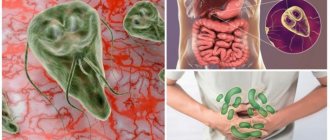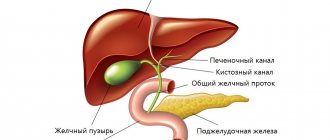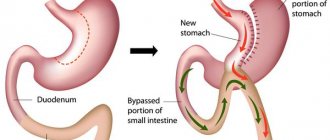Biliary dyskinesia is a common disease. Women get sick 10 times more often than men.
Contraction of the gallbladder occurs under the influence of the hormone cholecystokinin, which is secreted by the cells of the mucous membrane of the duodenum. Cholecystokinin is released under the influence of food. When food enters the duodenum, cholecystokinin is released, the gallbladder contracts, and the sphincter of Oddi relaxes. Bile is secreted into the duodenum. This whole process depends on the condition and tone of the gallbladder muscles, sphincters and the nature of the food.
By origin, primary and secondary dyskinesias of the gallbladder and biliary tract are distinguished
- Primary dyskinesia
occurs due to a violation of the neuromuscular regulation of the motor activity of the gallbladder and biliary sphincters. It is believed that this type of dyskinesia occurs in patients of asthenic physique who have neurotic or psycho-emotional disorders. In addition to the diagnosis of biliary dyskinesia, such patients are often diagnosed with neurocirculatory dystonia or vegetative-vascular dysfunction. The causes of dyskinesia are diseases of the endocrine system, in particular diseases of the thyroid gland, gonads, and menopause. - Secondary dyskinesia
of the gallbladder and biliary tract occurs in patients with diseases of other organs of the gastrointestinal tract (chronic gastritis, duodenitis, enteritis, colitis). Dyskinesias occur especially often in diseases of the duodenum, when, due to damage to the cells of the mucous membrane of the duodenum, their release of cholecystokinin is disrupted. Secondary dyskinesias also occur in patients with cholelithiasis or chronic cholecystitis.
Risk factors
Gallbladder dyskinesia is a polyetiological condition, so doctors need to take into account all possible forms of predisposition to the disease.
It is believed that gallbladder dysfunction may be associated with the patient's lifestyle, heredity and dietary habits. Key risk factors
- Family history of functional diseases of the gallbladder and its ducts. Hereditary factors are often associated with anatomical abnormalities.
- Infectious processes in the liver and bile ducts. Primarily these are hepatitis A and B.
- Surgical treatment of abdominal organs, abdominal trauma.
- Asthenic physique and psychoneurological disorders, accompanied by anxiety and apathy.
- Poor nutrition: excess fatty foods in the diet, snacks before bed, insufficient fluid intake.
- Chronic stress and insomnia.
- Insufficient physical activity.
- Diabetes.
Many risk factors can be eliminated with the help of a therapeutic diet and timely treatment of primary diseases of the gastrointestinal tract.
Causes of the disease
Violation of the outflow of bile can occur for various reasons, but all of them can be divided into two large groups.
The first is the primary causes, and then the symptoms of ADHD will appear in the following circumstances:
- 1. Stress and overload of the nervous system, or disruptions in the functioning of the autonomic nervous system.
- 2. Improper nutrition - irregular, overeating, too much fatty or low-quality foods in the diet, insufficient chewing.
- 3. Asthenic physique in adolescence and lack of body weight.
- 4. Allergic reactions – asthma, urticaria.
In this case, gallbladder dyskinesia, if it is not combined with other diseases of the digestive system, can be treated quite successfully.
The second group of causes of the disease is a combination with diseases of the stomach and intestines. The dysfunction here is not primary, so to eliminate it you will have to cure the underlying pathology. Usually this is cholecystitis, cholangitis, gastritis, peptic ulcer, duodenitis, pancreatitis.
Sometimes dyskinesia accompanies hepatitis, helminthic infestations, intestinal dysbiosis, and intestinal infections.
Pathogenesis
Normally, the evacuation of bile is a coordinated process: sequential contraction of the smooth muscles of the body and neck of the bladder leads to the reflux of fluid into the bile ducts. After cholecystokinin stimulates the relaxation of the sphincter of Oddi, the secretion enters the small intestine and participates in digestion. The nervous system provides activation or inhibition of the functions of the gallbladder, depending on external factors. Specialists are rarely able to determine which link of regulation has changed when a pathology occurs.
Dyskinesia of the gallbladder is primarily manifested by uneven contraction of different parts of the organ. Thus, a combination of rapid contraction of the bladder neck with weakened activity of the muscles of the body of the organ is possible. As a result, bile is not completely excreted, and the walls of the bladder are stretched, after which abdominal pain occurs. Additional symptoms are often caused by other autonomic disorders that affect the pain threshold. A long delay in the excretion of bile is complicated by the formation of stones and complete blockage of the ducts.
Classification
Gastroenterologists classify gallbladder dyskinesia according to the clinical manifestations of the disease, etiology and nature of the motility disorder. All these signs help to choose the optimal treatment for the disease.
Main types of dyskinesia
- Hypertensive motility disorder, manifested by rapid uncoordinated contractions of the gallbladder walls. In most cases, this form of dyskinesia is diagnosed in children and young patients. The main symptom is acute paroxysmal pain that lasts for several minutes.
- Hypotonic motility disorder, in which the gallbladder muscles contract too rarely or not strongly enough. Hypomotor dyskinesia is usually found in older patients. The pain is less acute and lasts longer.
Another classification includes secondary and primary forms of the disorder. Dyskinesia can occur independently due to a violation of innervation, an anatomical defect or hormonal imbalance, but more often a secondary form of the disease is diagnosed, which develops against the background of pathologies of other organs.
Treatment of dyskinesias of the gallbladder and biliary tract
First of all, it is necessary to normalize the diet, work and rest, and the state of the nervous system. For the hypertensive type of dyskinesia, a diet is prescribed excluding fried, spicy foods, seasonings, smoked foods, and alcoholic beverages. It is recommended to eat small portions, often. For pain, antispasmodics and sedative herbal mixtures are prescribed.
Physiotherapeutic and sanatorium-resort treatment and physical therapy are prescribed. With the hypokinetic variant of dyskinesia, the diet is somewhat expanded. Drugs that stimulate the motor activity of the biliary tract (xylitol, sorbitol, magnesium sulfate) are used. It is recommended to carry out duodenal intubation with the release of the gallbladder from bile or “closed tubes”, when the patient is recommended a special technique by which he can independently stimulate the contraction of the gallbladder. Physical therapy and sanatorium-resort treatment are mandatory.
Symptoms and signs
The clinical picture of the disease depends on the type of gallbladder motility disorder, the patient’s age and concomitant pathological conditions. The pain syndrome may last for several minutes or persist throughout the day. In general, the nature of pain is an important diagnostic marker.
Other signs:
- nausea and vomiting;
- loss of appetite;
- bloating;
- loose stools or constipation;
- bitterness in the mouth;
- yellowing of the mucous membranes and skin;
- insomnia;
- weakness and fatigue;
- dizziness;
- emotional lability.
Almost all symptoms of gallbladder dyskinesia are nonspecific, so accurate diagnosis is carried out only with the help of special examinations.
Prognosis and prevention
The disease will occur chronically throughout life, but by following a diet and a healthy lifestyle, the development of painful attacks can be avoided.
Among the complications of self-medication or non-compliance with doctor’s recommendations, calculous cholecystitis and cholangitis may develop.
Preventive measures include adherence to the principles of a healthy diet, normalization of sleep, avoidance of stress and mandatory treatment of diseases that can lead to the development of secondary VSD.
Diagnostics
To conduct an examination, the patient must contact a gastroenterologist. During the appointment, the doctor will ask the patient about complaints, collect anamnestic data and conduct a physical examination. An external examination allows the specialist to detect jaundice, bloating and pain in the right hypochondrium, but these pathological signs are not always present. The final diagnosis is determined after instrumental and laboratory studies.
Necessary diagnostic procedures
- Laboratory research. First, a blood test is performed to assess the number of white blood cells, determine liver function, and rule out infectious diseases. It is also recommended to test for Helicobacter.
- Ultrasound visualization of the gallbladder. This study does not always detect dyskinesia, but in some cases doctors detect an increase in organ volume and other anomalies. It is also possible to carry out imaging after eating and choleretic drugs: in patients suffering from dyskinesia, the volume of the gallbladder decreases by only 35-40%.
- Radionuclide diagnostics. The introduction of a special chemical marker into the patient’s body gives the specialist the opportunity to assess the functions of the liver and gallbladder.
- Retrograde cholangiopancreatography is a visual examination of the bile ducts and mucous membrane of the gastrointestinal tract.
- Computed tomography or magnetic resonance imaging of the abdominal organs. Obtaining three-dimensional images of these anatomical structures allows the doctor to more accurately determine the cause of the disease.
A gastroenterologist may order a limited number of tests to make a diagnosis after requesting a medical history and reviewing symptoms.
Therapeutic treatment
If impaired motility of the gallbladder is not complicated by severe structural pathologies, doctors prescribe only drug therapy. The main task is to normalize the functioning of the gallbladder and facilitate the evacuation of bile into the duodenum. Before prescribing specific medications, it is necessary to determine the type of disease.
Possible destinations:
- Myotropic antispasmodics that relax the smooth muscles of the gallbladder. These drugs are necessary for the hypertensive form of the disorder.
- Choleretic agents are substances that stimulate the functions of the liver and gallbladder. If the patient has too active muscle contractions, cholespasmolytics are needed to slow down the motility of the organ and eliminate spastic phenomena.
- Cholekinetics and prokinetics for weakened gallbladder motility. These drugs simultaneously improve the contraction of the organ and facilitate the release of bile into the intestines.
- Additional medications: anti-inflammatory drugs and antidepressants to eliminate complications of the disease.
In addition to drug therapy, patients are required to be prescribed a therapeutic diet. The recommended diet depends on the form of the motor disorder, but most often patients are prohibited from consuming too fatty foods and alcoholic beverages.
Dyskinesia (dysfunction) of the biliary tract
Treatment for gallbladder dysfunction includes:
- mode,
- diet therapy;
- drug therapy;
- physiotherapy;
- hydrotherapy;
- Spa treatment.
Treatment of patients with dysfunction of the gallbladder and sphincter of Oddi is often carried out on an outpatient basis.
Treatment of hypertensive type of gastric dyskinesia:
- With the hypertensive type of dyskinesia, a state of psycho-emotional comfort and peace is very important for patients. After the elimination of the pain syndrome and signs of exacerbation, the patient’s regimen expands.
- Diet therapy is essential. The general principles of the diet are a diet with frequent meals of small amounts of food (56 meals a day) with the last meal immediately before bed, which promotes regular emptying of the bile ducts and eliminates bile stagnation.
For the hypertensive type, it is recommended to limit foods that stimulate bladder contractions - animal fats, meat, fish, mushroom broths, eggs.
A good effect in this form of functional disorders is provided by drugs belonging to the group of cholespasmolytics.
The group of cholespasmolytics and anticholinergics includes the following drugs:
- Atropine sulfate, 0.1% solution is prescribed orally, 5-10 drops. appointment.
- Bellalgin (analgin 0.25 g; anesthesin 0.25 g; belladonna extract 0.015 g; sodium bicarbonate 0.1 g) take 0.51 tablets 2-3 times a day.
- Besalol (belladonna extract 0.01 g, phenyl salicylate 0.3 g) is prescribed 1 tablet. 2 times a day.
- Metacin is used 1 tablet. 2-3 times a day. For colic, the drug is injected subcutaneously or into the muscle, 1 ml of 0.1% solution.
- Platiphylline is prescribed 1 tablet. (0.005 g) 2-3 times a day before meals for 100 days. For colic, the drug is administered subcutaneously, 1 ml of a 2% solution 1-3 times a day.
- Euphylline (theophylline 80%; ethylenediamine 20%) 1 tablet. (0.15 g) 1 time per day.
- In case of hypertensive dysfunction of the gallbladder, cholespasmolytics of synthetic origin are more often used.
- Noshpa (drotaverine hydrochloride) is prescribed in tablets of 0.04 g 1-3 times a day for 14 days or more or in ampoules of 2 ml of a 2% solution intramuscularly or intravenously 1-2 times a day.
- Papaverine (papaverine hydrochloride) is prescribed orally in tablets of 0.04 or 0.01 g 3 times a day or intramuscularly (intravenously) 2 ml of a 2% solution.
Combined cholespasmolytics include nicoshpan (nicotinic acid 22%; drotaverine hydrochloride 78%) 20 mg 1-2 times a day and papazole (dibazol 0.03 g; papaverine hydrochloride 0.03 g) 1 tablet. 2-3 times a day The disadvantage of drugs in this group is their non-selectivity, i.e. they act on the entire smooth muscle latura, including the urinary tract and blood vessels, and there is also the possibility of developing hypomotor dyskinesia and hypotension of the sphincter apparatus of the gastrointestinal tract.
The modern drug duspatalin (mebeverine), belonging to the group of myotropic antispasmodics, has a direct blocking effect on the fast sodium channels of the myocyte cell membrane, which disrupts the influx of Na+ into the cell, slows down the depolarization processes and blocks the entry of Ca2+ into the cell through slow channels, preventing the development of muscle spasm and pain syndrome. Duspataline has no effect on muscarinic receptors, which means that there are no side effects such as dry mouth, blurred vision, tachycardia, urinary retention, constipation, and weakness. The drug has a prolonged action; it is prescribed no more than 2 times a day in the form of 200 mg capsules for 2-4 weeks. By increasing the flow of bile into the small intestine, myotropic antispasmodics help improve digestion processes and activate intestinal motility, which leads to normalization of stool. Myotropic antispasmodics include selective blockers of calcium channels of smooth muscles: minavirin bromide (dicetel), it is prescribed 50-100 mg 3 times a day; spasmolin (otilonium bromide).
Odeston (7-hydroxy-4-methylcoumarin) is a myotropic antispasmodic with a choleretic effect. The drug enhances the formation and separation of bile, has a selective antispasmodic effect on the sphincter of Oddi and the sphincter of the gallbladder, which promotes good outflow of bile from the liver and biliary tract. Odeston has an indirect choleretic effect by facilitating the passage of bile into the gastrointestinal tract, which enhances the recirculation of bile acids. The advantage of the drug is the absence of adverse effects on the smooth muscles of the vascular walls and intestinal muscles; it does not increase pressure in the bile ducts and also does not impair the secretory function of the digestive glands and the absorption of nutrients. Thus, odeston helps improve digestion and peristalsis, normalize stool, eliminate constipation, and has a positive effect in cases of sphincter of Oddi dysfunction, dyskinesia of the gastrointestinal tract, chronic cholecystitis (including uncomplicated calculous), as well as in cases of disruption of the digestive processes caused by a deficiency of bile in the intestine. The daily dose of odeston is 600 mg (1 tablet 3 times a day). The duration of treatment is individual (from 1 to 3 weeks).
For biliary dyskinesia, herbal remedies such as arnica (flowers, tincture), valerian (rhizomes with roots), elecampane (rhizomes with roots), St. John's wort (herb), lemon balm (herb), peppermint (leaves), calendula are used (flowers), marshweed (herb), sage (leaves), convaflavin, olimetin, holagol, calamus, immortelle budra, capitol, snake knotweed, gorse, oregano, St. John's wort, centaury strawberry, calendula, willowherb, horseweed, hoofed grass, nettle , oregano, corn silk, cinquefoil erecta, flax, juniper, mint, dandelion, shepherd's purse, plantain, tansy, wormwood, kidney tea, wheatgrass, strap, rose, chamomile, knotweed, thuja, dill, fennel, hops, chicory, thyme, blueberry, celandine, sage, rosehip
In case of bladder dysfunction caused by increased tone of the sphincters of the biliary system, the intake of medications that have a choleretic and hydrocholeretic effect (bile acids, enzyme preparations, infusions and decoctions of choleretic herbs, synthetic choleretic drugs, gastric juice, etc.) is limited.
In order to stimulate bile secretion, reduce the tone of the common bile duct, which increases the flow of bile into the duodenum, cholekinetics are used - drugs that cause the production of cholecytokinin, which controls the kinetics of the gallbladder and sphincter of Oddi. The effect is due to the irritating effect of drugs of this group on the receptor apparatus of the duodenal mucosa.
In order to stimulate the formation and outflow of bile, as well as an antispasmodic effect, tea is used, which includes the following plants: spinach leaves (Folia Spinaciae), thistle fruits (Fructus Cardui Mariae), cinquefoil herb (Herba Anserinae), celandine herb (Herba Cheh' dorm), yarrow herb (Herba Millefolii), licorice root (Radix Liqumtae), rhubarb rhizome (Rhizoma Rhei), dandelion root and herb (Radix Taraxaci p. Herba), turmeric rhizome, turmeric oil (Rhizoma Curcumae, Oleum Curcumae) , aloe extract (Extractum Aloes).
A number of medicinal plants have a cholekinetic effect: (berberine sulfate), extracts from medicinal plant materials (calamus, rhizomes), barberry (tincture of leaves), sandy immortelle (flowers), lingonberry (leaves, shoots), blue cornflower (flowers), watch trifoliate (leaves), knotweed (herb), oregano (herb), calendula (flowers), coriander (fruit), juniper (fruit), dandelion (roots), shepherd's purse (herb), rhubarb (root), chamomile (flowers ), common thyme (herb), caraway (fruit), yarrow (herb), rose hips (fruit, cholosas), fennel (fruit).
The approximate treatment regimen for hypermotor dyskinesia of the gallbladder is the use of antispasmodics for rapid relief of pain (phosphodiesterase inhibitors - noshpa, papaverine) or anticholinergics (atropine, platyphylline) in combination with hepabene to reduce the tone of the sphincter of Oddi.
Treatment of hypotonic type of gastric dyskinesia. In the treatment of gallbladder dysfunction of the hypotonic type, it is advisable to expand the motor regimen.
These individuals tolerate weak broths, fish soup, cream, and sour cream well. Food with sufficient vegetable fat content (up to 80 g/day) and eggs are used. For 2-3 weeks, vegetable oil is prescribed, 1 tsp. 2-3 times a day 30 minutes before meals. To prevent constipation, raw vegetables are recommended: carrots, pumpkin, zucchini, greens. Bran has a pronounced effect on the motility of the biliary tract (1 tablespoon is brewed with boiling water and added as a gruel to various side dishes).
Prokinetics indicated: cisapride 5-10 mg 3 times a day; domperidone 5-10 mg 3 times a day 30 minutes before meals; metoclopramide 5-10 mg per day.
Drugs from the choleretic group, as well as bile acid drugs, have a good effect.
Drugs containing bile acids include the following:
- Lyobil (lyophilized bovine bile), tablets 0.2 g, 1-2 tablets. 3 times a day after meals. Course 1-2 months.
- Decholin (sodium salt of dehydrocholic acid), ampoules of 5 ml of 5% and 20% solution, administered intravenously 5-10 ml once a day.
- Cholecin (a compound of a salt of deoxycholic acid and a sodium salt of higher fatty acids) is prescribed in 1-2 tablets. 3 times a day before meals.
- Hologon (dehydrocholic acid), tablets 0.2 g, 0.2-0.25 g once a day. The course of treatment is 2-3 weeks.
Preparations of plant origin and medicinal plants that have a choleretic effect have a good effect on the function of the gallbladder: aqueous extracts from medicinal plant raw materials calamus (rhizome), barberry (leaf, root), birch (buds, leaves), immortelle sandy (flowers), barberry multi-veined (herb), knotweed (herb), goldenweed (herb), coriander (fruit), corn (columns with stigmas), burdock (roots), tansy (flowers), wormwood (herb), rowan (fruit ), hops (cones), chicory (herb), choleretic herbs No. 1 and 2, combined herbal remedies (holagogum, cholagol, holaflux, hepatofalplanta, hepabene, kurepar, flamin, fumetere, etc.).
In the presence of hypomotor dysfunction of the gallbladder against the background of increased tone of the sphincters of the extrahepatic bile ducts, Odeston 200 mg 3-4 times a day is added to drugs that enhance the contractile function of the gallbladder.
Effective in the treatment of hypomotor dyskinesia of the gallbladder with normal motor function of the gastrointestinal tract is the combined use of prokinetic drugs (metoclopromide, or domperidone, or 5-10% solution of magnesium sulfate, 1 tablespoon 2-4 times a day for 10-15 minutes before meals) with choleretic drugs containing bile acids or herbal products (allochol, cholenzyme, hepabene). Long-lasting biliary sludge during or after this therapy is an indication for the use of UDCA drugs for up to 3-6 months.
To correct hypomotor dyskinesia of the gallbladder in case of its combination with gastrointestinal tract and/or duodenostasis, a 2-week (if indicated and longer) treatment regimen is used, including prokinetics; choleretic preparations of plant origin or containing bile acids; antibacterial drugs in the presence of symptoms of bacterial contamination of the small intestine.
In the case of hypomotor dyskinesia of the gallbladder and colon, 24-week therapy is recommended, which includes prokinetics and choleretic drugs containing bile acids.
When hypofunction of the gallbladder is combined with intestinal hypermotility and dysbiosis, treatment with hepabene in combination with hilacomfort is indicated. In addition to these medications, intestinal adsorbents such as smecta, phosphalugel, etc. can be prescribed.
It is very effective to use probeless tubes with a decoction of rosehip, corn silk, warm mineral water, 10-25% solution of magnesium sulfate (1-2 tablespoons 2 times a day) or 10% solution of sorbitol or xylitol (50 ml 2 times in a day).
Method of “blind” probing according to Demyanovich
“Blind” probing is prescribed 23 times a week for 1 month. Probing is carried out as follows:
- In the morning on an empty stomach, the patient is given to drink 15-20 ml of a 33% solution of magnesia sulfate, heated to 40-50 ° C (instead of magnesia sulfate, you can use 1-2 egg yolks, warm olive or corn oil; 10% solutions of sorbitol, xylitol; warm mineral water type Essentuki-17; a glass of beet juice).
- It is necessary to place the patient on the right side on a cushion with a heat pad or paraffin application on the right side.
- During the procedure, take deep breaths (to open the sphinter of Oddi) - 23 breaths every 5 minutes.
Patients with biliary tract dysfunction are advised to use acupuncture and rational psychotherapy, which improves the psycho-emotional state, reduces the intensity of autonomic reactions and pain. It is important for the doctor to contact the patient, explain the causes of the disease and possible ways to eliminate it. Trust in the doctor largely determines the success of treatment.
Pharmacological correction of psychoneurological disorders is carried out with antidepressants. For this purpose, tricyclic antidepressants are used: amitriptyline, drugs with a serotonin reuptake mechanism (fevarin, Framex, etc.).
For vegetative-vascular dystonia and neurotic-neurosis-like syndrome, “minor” tranquilizers (Elenium, Tazepam, etc.) and sedatives are recommended: tincture of valerian, motherwort, 40 drops. 3-4 times a day or an infusion of these plants (10 g per 200 ml) 1 tbsp. l. 4 times a day.
Physiotherapeutic procedures are used in the treatment of gallbladder dysfunction:
- To improve microcirculation and trophic processes in patients with hypertensive dyskinesia, inductothermy is indicated.
- For hypotension, diadynamic currents and faradization of the gallbladder are prescribed.
- UHF has anti-inflammatory and bactericidal effects.
- Microwave therapy improves blood flow, tissue trophism, enhances redox processes, has anti-inflammatory and analgesic effects, and relieves spasms of the biliary tract.
- Applications of paraffin and ozokerite improve blood flow and tissue trophism, have a resolving effect and the ability to cause an antispasmodic effect in hypertensive biliary dyskinesia.
- For hypertensive dyskinesias, electrophoresis of a 5% novocaine solution and a 10% magnesium sulfate solution is indicated.
- Baths (pine, pearl) are prescribed every other day, for a course of 10-12 baths.
- Showers (rain, fan, circular) are recommended for 35 minutes, 10-15 procedures per course.
- Massage of the cervical collar area No. 10. Galvanic collar on the collar area.
- Electrophoresis of calcium chloride, bromine solution on the collar area, for a course of 7-10 procedures. Electrophoresis of 5% novocaine solution, 0.1% papaverine solution, 5% magnesium sulfate on the area of the right hypochondrium, for a course of 7-10 procedures.
Forecast:
The prognosis for dyskinesia is favorable. Working capacity has been preserved.
Surgery
An indication for surgical intervention may be complicated dyskinesia, which cannot be eliminated with drug therapy. Surgery is also prescribed for severe pain and severe digestive disorders. Before surgical treatment, it is important to exclude other pathologies of the gallbladder, such as cholelithiasis or the growth of a malignant tumor. According to modern research, radical treatment is more effective in relieving the symptoms of the disorder.
Depending on the indications and condition of the patient, the doctor may perform an open or laparoscopic cholecystectomy. The operation involves removing the gallbladder. After the intervention, the functions of the digestive system are normalized, but some complications may develop, such as dyslipoproteinemia or dysfunction of the sphincter of Oddi.
Question answer
Women get sick 10 times more often than men.
The primary type most often occurs in individuals with autonomic dysfunctions, nervous disorders, poor diet and sleep disorders. Secondary pathology develops against the background of diseases of the digestive system, hepatitis, after removal of the gallbladder. The likelihood of getting sick is influenced by hormonal levels and the presence of certain chronic diseases in the anamnesis.
If treated incorrectly, the risk of gallstones formation, acute or chronic pancreatitis, cholecystitis, and reflux gastritis increases. All this is difficult to treat and seriously affects the patient’s health.
Prognosis and complications
Prognostic data depend on the form of pathology, concomitant diseases and the age of the patient. If gallbladder dyskinesia is not complicated by other disorders, the prognosis is favorable. In most cases, drug therapy can achieve significant improvements.
Possible complications:
- hepatic encephalopathy with prolonged bile retention;
- inflammation of the gallbladder and its ducts;
- the occurrence of secondary infection;
- insufficient supply of nutrients to the body.
To prevent the development of complications, it is necessary to follow a therapeutic diet.
Prevention
Many diseases of the digestive system are long-term consequences of an unhealthy lifestyle, so preventive measures help prevent dysfunction of the gallbladder and its ducts. First of all, doctors recommend paying attention to primary pathologies and nutritional habits.
Basic recommendations
- Improving your diet: avoiding too fatty foods, fried foods, alcohol and excess spices. Adequate fluid intake.
- Normalization of body weight and regular physical activity.
- Avoiding stress, treating anxiety.
- Timely detection and treatment of inflammatory processes in the gallbladder and intestines.
- Regular examinations by a gastroenterologist in the presence of chronic diseases of the digestive system.
- Refusal of hormonal contraceptives and somatostatin drugs.
Thus, gallbladder dyskinesia is a common disease manifested by impaired motility of the organ. Insufficient bile secretion can lead to serious complications, so this disorder must be treated when the first symptoms appear. Most often, taking medications and lifestyle changes is enough.
Types of dyskinesia
According to the nature of the motor dysfunction, the gallbladder is divided into hyperkinetic (contractions of the gallbladder are increased) and hypokinetic (the walls relax, the outflow of bile is slowed). In the first case, symptoms of dyskinesia are observed, such as intense pain radiating to the scapula and manifesting itself in paroxysms, as well as nausea (in rare cases, vomiting).
Characteristic signs of hypokinetic disease:
- feeling of fullness, heaviness in the stomach;
- mild pain in the right hypochondrium;
- problems with stool (diarrhea, constipation);
- change in color of stool;
- an increase in bilirubin, cholesterol in the blood, the formation of clots, gallstones.
Dyskinesia can also be classified according to the mechanism of etiology into primary and secondary. For example, in the first case we are talking about an incorrect lifestyle, in the second the disease is provoked by concomitant pathological processes.








